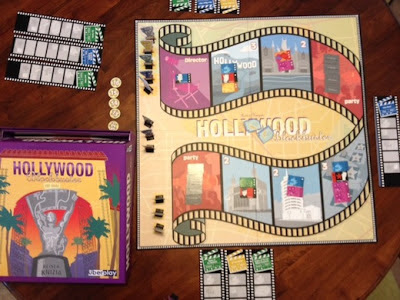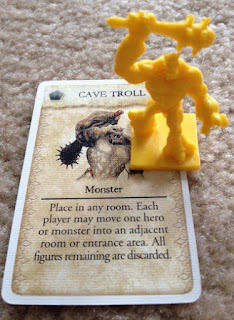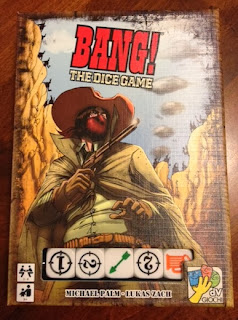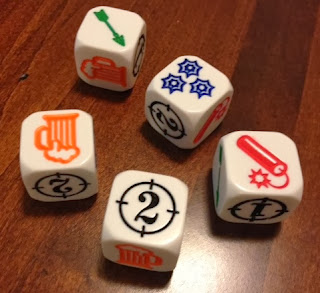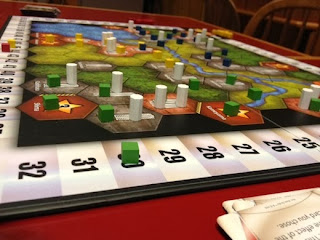Recently I've gotten several opportunities to play a game called Hollywood Blockbuster. You should know - there are several different versions of this game, and I think that the current one is called "Dream Factory." However, I'm not entirely sure what (if anything) has changed, so I will go ahead and review based off of my version of the game.
In Hollywood Blockbuster, each player takes on the role of a movie studio trying to have the most successful year. Success is based on the number of stars on a movie as well as the number of awards the movie earns. Play is divided over four rounds ("quarters"), and at the end of the year, best movie awards are handed out. Each quarter consists of a number of auctions and parties. In each auction, the players are bidding contracts (the currency of Hollywood), on various pieces for their movie - it could be for special effects, sound work, actors, guest stars, directors, or agents (which are wild). All of the auction tiles are face up from the beginning, so that you know what else is available. Whenever a player successfully wins and auction, he must immediately place or discard all of the new tiles that he has purchased (generally you win 2-3 tiles). In addition, once the winning bidder pays for his new tiles, all of the other players get to divide the contracts spent among themselves. Parties work a little differently. Once you arrive at a party space, all of the tiles are flipped face up. Then, starting with the player that has the most actors and guest stars ("star power"), each player gets to select a tile (for free) to add to his board. As soon as a player completes one of his (up to three) in progress movies, he calculates the score and collects the corresponding scoring tile; then he receives another potential movie from the stack. If he has completed the first movie of a given genre, then he wins a smaller award. Plus, at the end of each of the first three quarters, whoever has the overall best movie gets a small award. At the end of the game, all of the final awards are handed out, and the player with the best total score between awards, completed movies, and leftover contracts wins the game.
 |
| Each movie has different needs |
The second auction element that I think works well is the fact that tiles are grouped together. There is only one auction per round in which a player buys a single tile - the first auction (which is for a 4-star director). After that, the auctions will always be for at least two tiles. I like this because it will cause more bidding wars than if the players were bidding on single tiles. Sometimes this war will be because one player wants the sound board, and another wants the special effects. Sometimes it will be because both players are just desperate to fill several empty places on their movie. Sometimes the only special effects available for the round are paired with the best actor. But, overall, auctioning several things at a time allows much more tension and excitement to be in the game.
My third pro for Hollywood Blockbuster is about the only other way of gaining tiles - parties. I like the intrigue that parties present, where you don't know how good they will be. Because you don't know what will be available, you always hope for the best. What this indirectly does is increase the value of actors. In addition to helping you with your movie, if you are able to purchase a lot of actor tiles, then you will get to pick first at the party, thus potentially giving you a nice 3-star tile for free. And, of course, the downside of not having actors is that your opponents might get to pick a nice 3-star tile for free! Of course, you might show up to the party, and there is nothing that you want. I feel like the parties are a perfect element of controlled randomness in the game.
 |
| You don't have to win awards - but you should |
The last thing that I will mention about Hollywood Blockbuster is more of a "point of note." My copy of the game doesn't have licenses to any movies or actor names, so they are all spoofs. You will see things like "Star Battles" instead of Star Wars, "The Prince Groom" instead of The Princess Bride, "Jim Scarry" instead of Jim Carrey, and "Dental Washington" instead of Denzel Washington. Some people will like this, and will enjoy trying to figure out what all of the spoof names are referring to, whereas other people will probably be annoyed by it. I know that at least one German version of the game is able to use actual actors and actresses (I'm not sure about movies), but it uses historically famous people - like Marilyn Monroe and Frank Sinatra. I am unsure of how Dream Factory addresses this issue. Anyway, if this is something that is important to you, I'd recommend you looking at the different versions to decide which one will fit your tastes.
Overall, I give Hollywood Blockbuster a 9.0/10. I really enjoy the game, and I intend to keep it in my ever-growing collection of auction games.
If Hollywood Blockbuster sounds interesting, then you might also check out Mice and Mystics, Notre Dame, and Legacy: Gears of Time.
